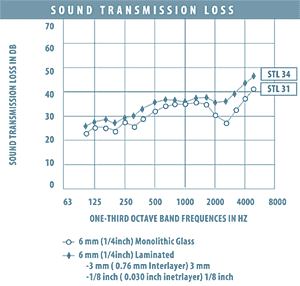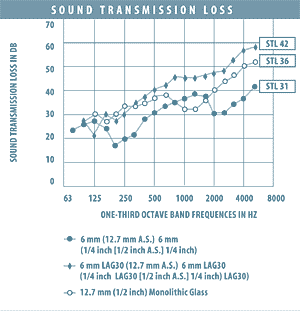Exploring the High-Performance Benefits of Laminated Glass
Sound
Anyone who has ridden in a luxury automobile has likely noticed the dramatic difference in perceived interior noise between luxury and economy cars. Today, the same technology used to dampen noise in cars is being used in building architecture. In many building types ranging from concert halls and office buildings to homes and schools, isolating interior spaces from exterior noise is critical, and laminated glass effectively reduces sound transmission between indoor and outdoor spaces.
Sound transmission through glass or any other building material is related to the limp/mass law. The heavier and more flexible the building material is, the better it will be at reducing sound transmissions. Because ordinary monolithic glass is essentially lightweight and very stiff, it tends to transmit more sound than other building materials.
|
Adding laminated glass to a glazing system is one of the best ways to optimize performance. The PVB interlayer effectively absorbs significantly higher levels of soundwaves than monolithic glass, thus creating a greater sound barrier. Adding a pane of laminated glass to an insulating glazing system gives the unit an even higher Sound Transmission Class (STC), blocking more soundwaves.
The key to creating an acoustically insulated indoor environment is to select products with a high STC, which is used by acoustical engineers as a measure of a building materials' resistance to the passage of sound. The higher the STC, the better the sound barrier.
|
Acoustic performance is especially critical in airports and surrounding structures, hotels, restaurants, and schools. At the San Francisco Airport International Terminal, designed by Skidmore, Owings and Merrill, LLP, laminated glass dampens noise of runway activity and overhead air traffic and provides seismic protection. On the other coast, the Westin New York hotel in Times Square, designed by Arquitectonica, uses insulating laminated glass with high-performance coatings to minimize outside noise from busy midtown Manhattan. The innovative design features a colored glass panel exterior that blocks sound and provides guests with a quiet indoor oasis in New York City.
Use of laminated glass for noise reduction provides building occupants with the highest level of environmental comfort. The glass blocks noise and lets in natural light. In addition to walls and windows, laminated glass can also be used in interior applications such as floors, shower and bath enclosures, partitions and room dividers, elevators, and doors.
In these applications, laminated glass helps eliminates the "cocktail effect" in interior spaces, in which multiple voices, noise sources, and reverberations occur in an occupied space. A room with high noise absorption will yield an environment that is conducive to improved hearing and higher productivity.











